#P. Noval Sampaloc Manila
Explore tagged Tumblr posts
Photo


Unli wings for P200.00 and 4 pc chicken + java rice for only P69.00 ❗️ 📍 Catchy Diner P. Noval Sampaloc, Manila 10.03.2019 | 📸 @kristinemaeb
#2019#2019Oct#buhayestudyante#chickenmeals#chickenwings#unliwings#catchydiner#foodfinds#wheninmanila#budgetfriendly#foodstagram#foodie#manilafoodie#ubelt#krizeats#kristinemaebsnapshots#P. Noval Sampaloc Manila#Catchy Diner#java rice
0 notes
Text
No Grace Falls Upon the Careless
My BDRRM Kwentuhan
I can recall how a Theology professor of mine once said that “in disasters, there is grace,” while she was discussing a lesson in class. I took note of that a few weeks ago because that was just one of life’s ironies that dawns upon you every now and then. At some point I agreed to it—especially how, as Filipinos, it can be evident knowing how resilient we are. Filipinos can be seen managing to flash out smiles amid the flooding and chaos. We manage to swim in our own pieces of tragedy that floods us every now and then, but I realized that this shouldn’t really be something we should be proud of. Yes, resilience is important, but it shouldn’t be romanticized; the chaos behind it shouldn’t be taken for granted. At some point, again, I started to question my professor’s statement. How was it going to be true for those who didn’t make it? Knowing how difficult it must be for my fellow citizens, this activity made me ponder more. With my interview with Kagawad Edgar Estigoy, the barangay official assigned to disaster management, I picked up numerous points that made me analyze my own community’s situation and whether or not the quote I acquired from our teacher applied to the people in it.
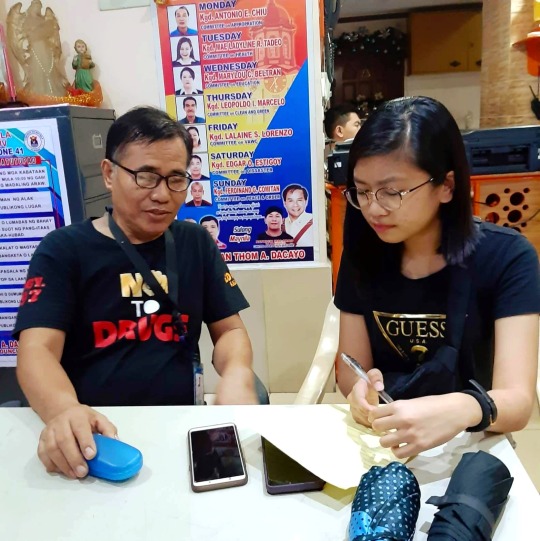
According to the notes given to us in our NSTP course, hazards are “any phenomenon, substance or situation, which has the potential to cause disruption or damage to infrastructure and services, people, their property and their environment.” Knowing how anyone can be subject to danger no matter where they reside, I had Kagawad Edgar identify the hazards that had been present in our community—Brgy. 397, Zone 41, Sampaloc, Manila.
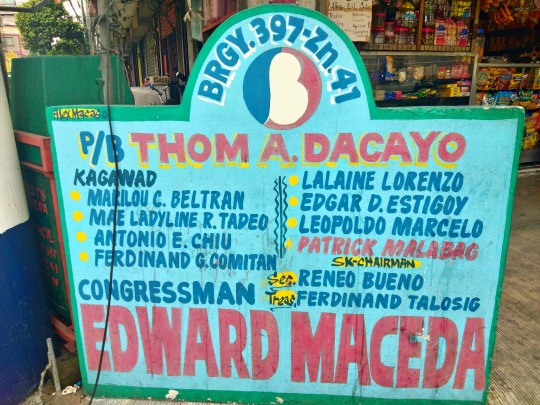
According to him, the heaviest calamities that had hit the barangay were typhoons Ondoy and Piping. He referred to these as the worst as he recalled how the barangay was in deep flood for hours due to heavy rainfall and winds. The streets surrounding the community, especially España, weren’t fully developed as the drainage systems weren’t functioning well. These changed when a mega dyke was built in Blumentrit to mitigate the situation as told by Kagawad Estigoy. Another hazard that had hit the barangay, but fortunately has not affected it much, were the earthquakes. To be more aware or cautious about these things, he mentioned that we are already living in the age wherein Information Technology is very accessible and prevalent. This helps the council be on the lookout for incoming calamities. Indeed, the term “high tech” has been familiar to us, and this has paved the way for people to communicate and disseminate information easily. Aside from this, Kagawad expressed that there are organizations involved in providing people information like the Bureau of Communication Services, National Telecommunications Commission, and PAGASA. They also have what they call a “Public Address”, barangay tanods that roam around, and volunteers to help spread info. Basically, they become aware of an incoming disaster when they get the “nationwide notification” or warning; they, then, notify the residents of the barangay. What probably is a good thing amid all the disasters is how the community is not badly affected no matter how often these come. To give examples, Kagawad Estigoy cited how the recent typhoon Tisoy came yet the worst we’ve experienced out of it were heavy rains and strong winds that thankfully didn’t come to the point of destruction compared to the regions that had to go through being badly damaged like Isabela, Cagayan, Mindoro, Albay, Bicol, and Leyte (as cited from the interview).
When it comes to assessing people at risk in the community, the ones who fell under the most vulnerable to hazards were those who were near establishments made out of wood, which were the areas that were also considered the most dangerous within the community. This is because wood can easily catch fire which--something that cannot be easily put out. This kind of establishments would also be easily “washed out” by floods and destructed by winds. But in the community’s case, very few infrastructures are still made out of wood as most (within the streets of Moret, Galicia, P. Noval, and Tolentino) are already concrete.

According to Kagawad Estigoy, in times of disasters, those who will be largely affected would be the workers or “mga taong naghahanap-buhay”. He said that we cannot be sure with the financial stability of anyone and meant that not everyone has jobs that can sustain each day which can be affected with a single hit of a storm. Despite this, in terms of vulnerability and facing calamities, the interviewee said that the residents are not really affected to the extent that services will run out as the people are always willing help each other out, as well as give or donate resources. On the other hand, the safest place that can be located within and near the barangay were the open spaces and evacuation areas in the Paaralang Juan Luna and the field of University of Santo Tomas. Kagawad also added that the concrete establishments that surrounded the barangay were informed to be open and accessible to all to be evacuated in during emergencies, especially the building wherein the Chairman of the barangay resided. He said that they were tasked to give way to those who badly needed help or shelter and not be selfish with space. So far, there isn’t an existing problem that the barangay is facing which prevents it from being a better community to live in or from rising up again because in the first place, the fall is already prevented.
In assessing the capacity and disaster management, the council of barangay 397 equips itself and the community with supplies that is ready to use in times of dangerous situations. These evacuating tools include first aid kits, wood cutters and saws (incase of situations that would require removing big obstacles like trees that would fall on cars or roads), machines, ropes, emergency vehicles, and more. The council also makes sure to disseminate information to the community when there is an incoming danger. To help the people be prepared for any disasters, activities like fire drills and earthquake drills are conducted for the safety and awareness of everybody. The barangay council, community volunteers, and support from NGOs all help in the protection and preservation of peace and safety of the barangay.
My Community Walk
After gathering information from Kagawad Estigoy, I took a community walk to assess and check if the data I have accumulated matched the barangay’s situation. Below are what I have captured with regards to the hazardous areas, safest places, and best practices around the community.The hazardous places or spaces that I have captured included (1) infrastructures made out of wood since, as the interviewee had mentioned, it could easily catch fire and is feeble enough to be destroyed by strong winds and floods,
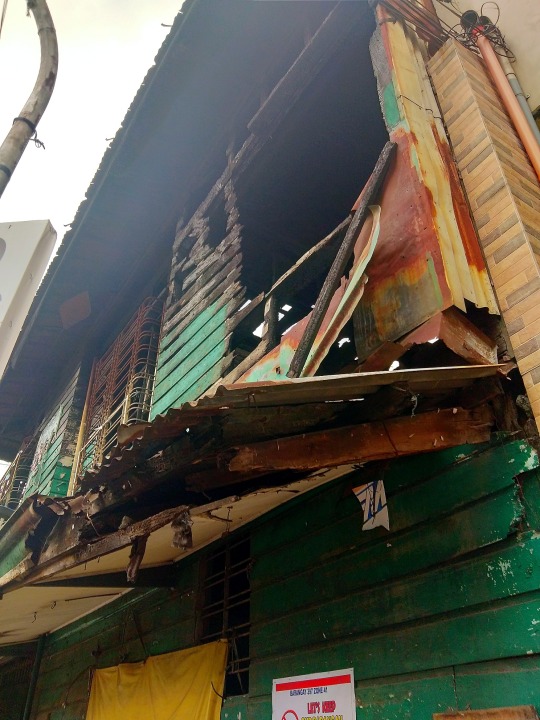
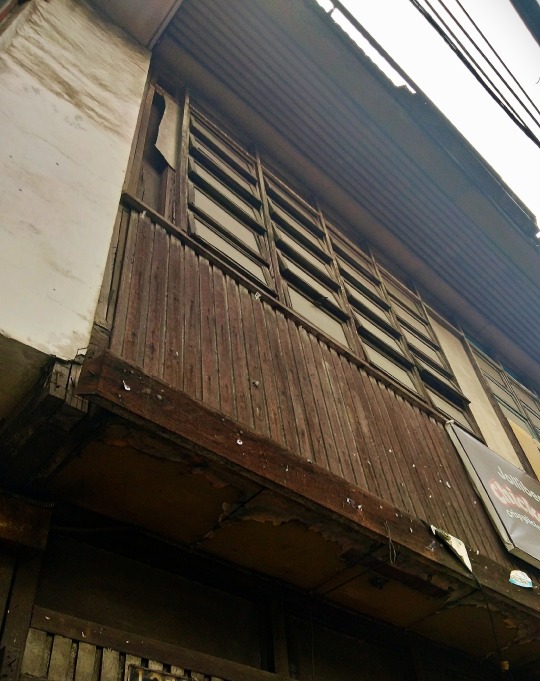
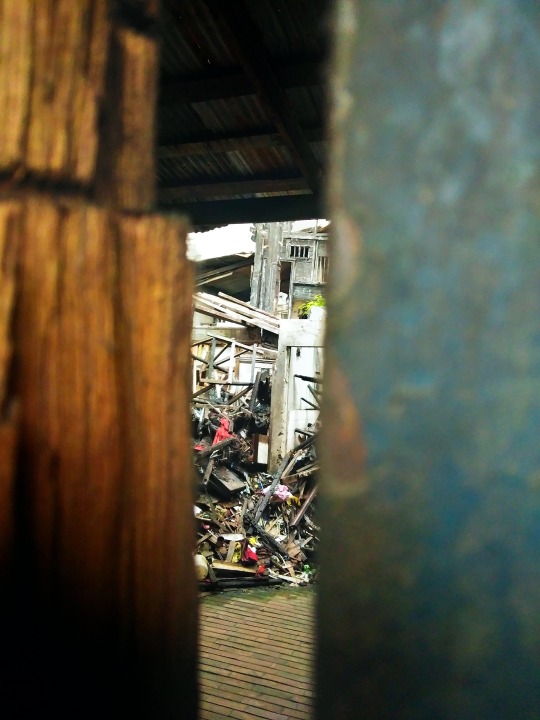
(2) sidewalk and road blockages/damages that have no proper warning signages which could put people in danger such as making them fall, trip, or are simply being obstructions,
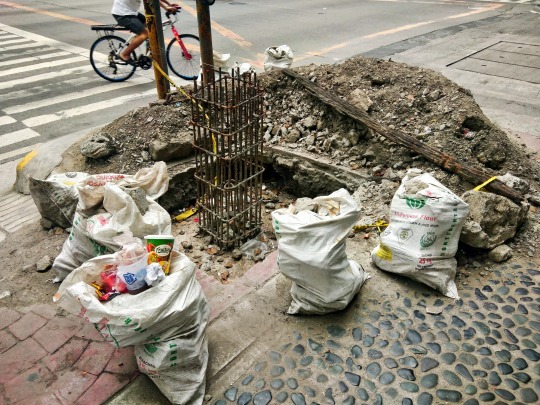
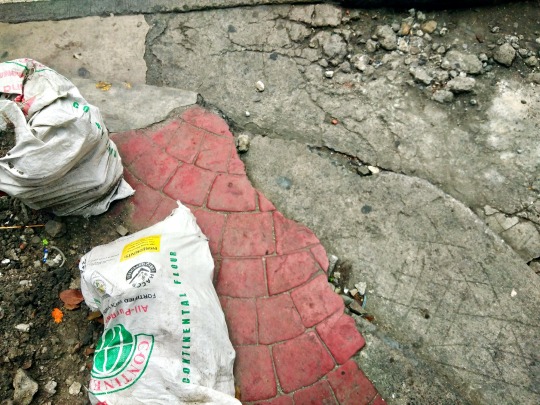
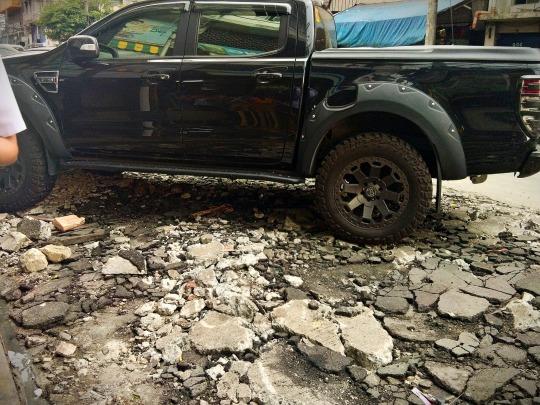
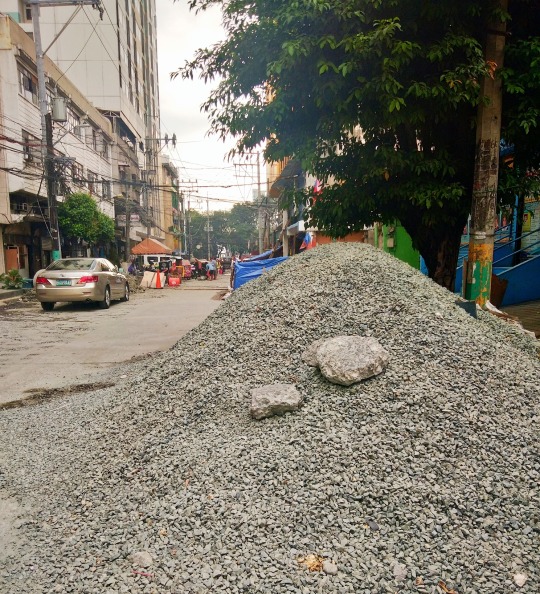
and (3) open construction sites that are too close to roads and establishments that is hazardous for many passersby that do not have PPE (Proper Protective Equipment).
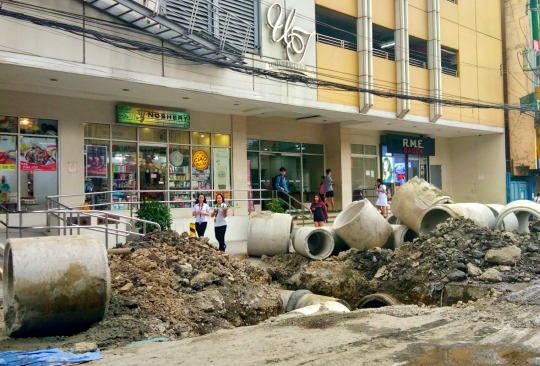
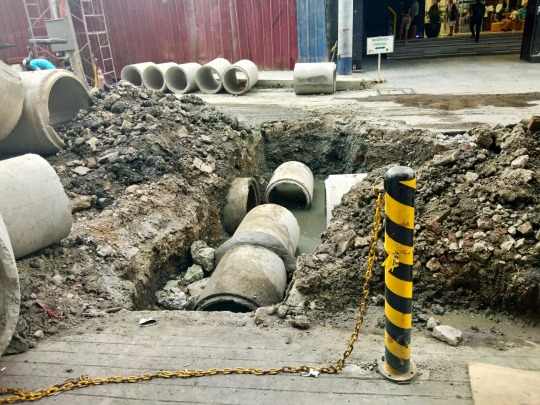
Some issues I have noticed were (1) the presence of too many electrical wirings that were all messily looped together which can be a cause for fire

and (2) the presence of heavy-duty equipment near construction sites that were just lying around unsecured.
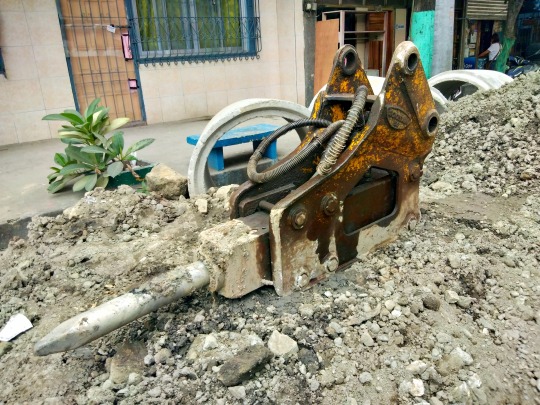
A hazardous practice I have captured is the construction workers act of not wearing PPE’s while working which could harm them while they do their jobs.
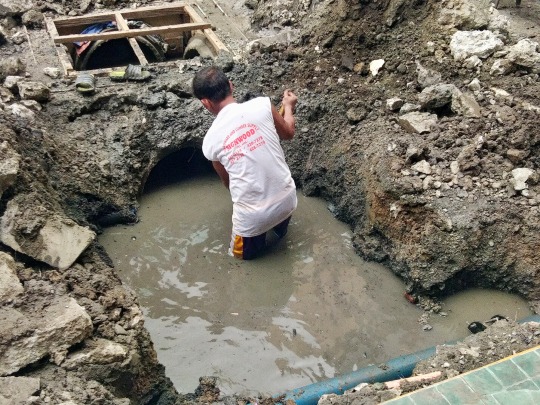
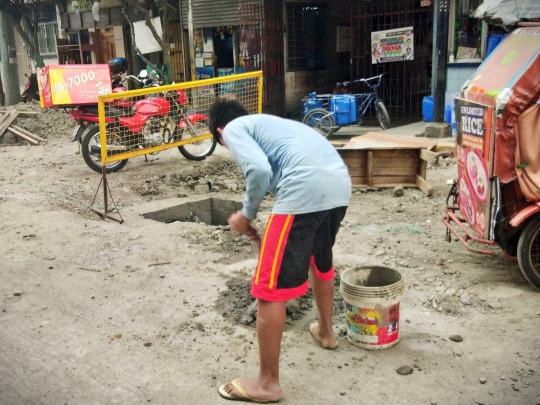
The safest places, as mentioned earlier, are the (1) UST field,
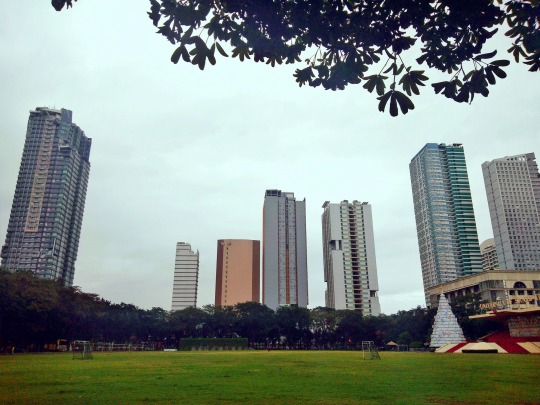
(2) Paaralang Juan Luna,
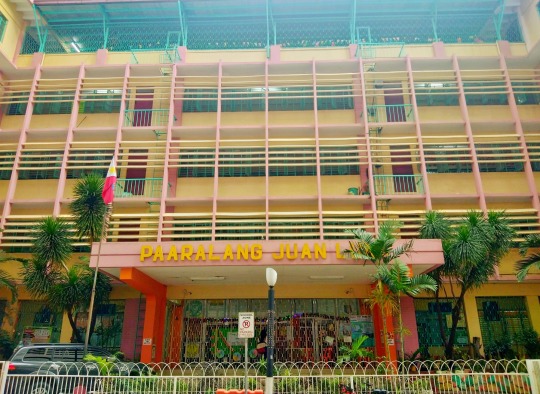
and (3) the barangay hall itself which is also where the barangay chairman resides.
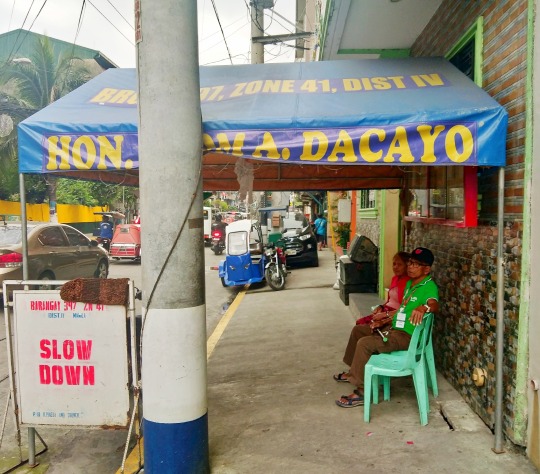

Last but definitely not the least, some best practices I have witnessed in the entirety of my community walk were (1) the proper segregation of waste (as there were trash bins in almost every corner in the community) and designated areas for recyclable materials,
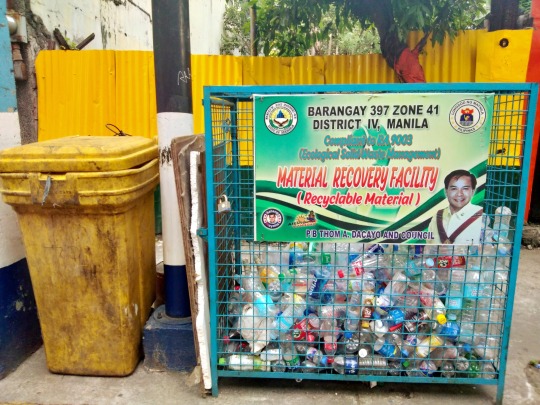
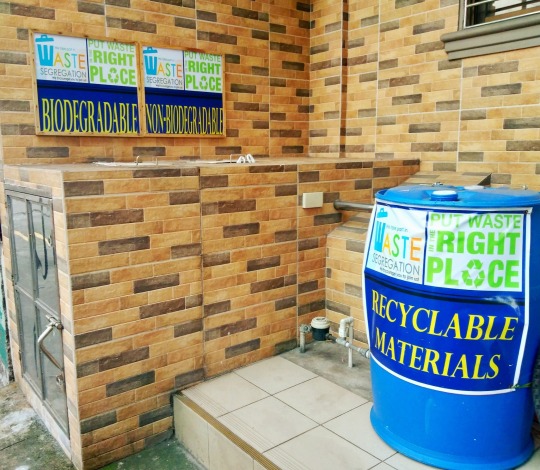
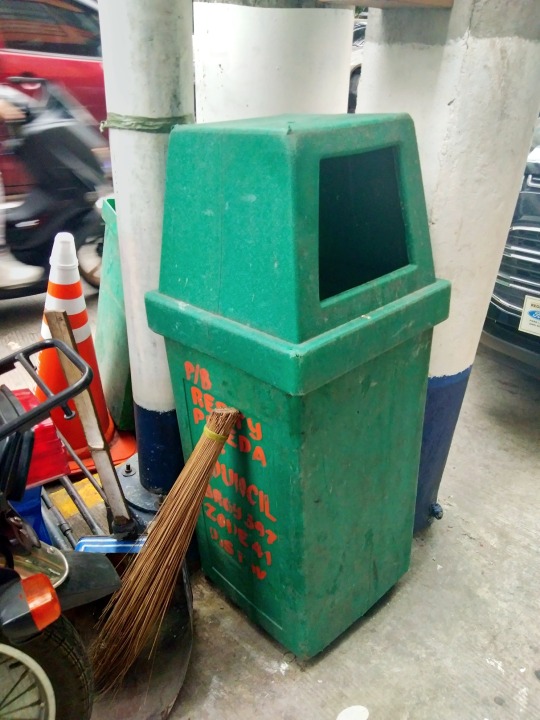
(2) the presence of many security cameras (for proper surveillance) and a warning horn (for important announcements),

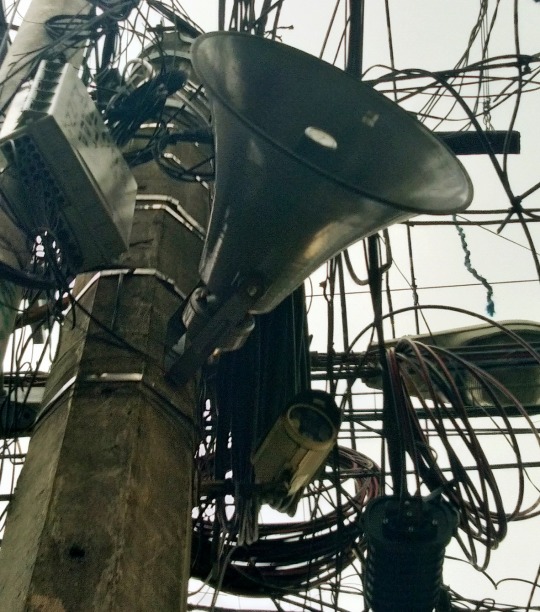
and (3) ready-to-go barangay vehicles that were provided for disaster response.
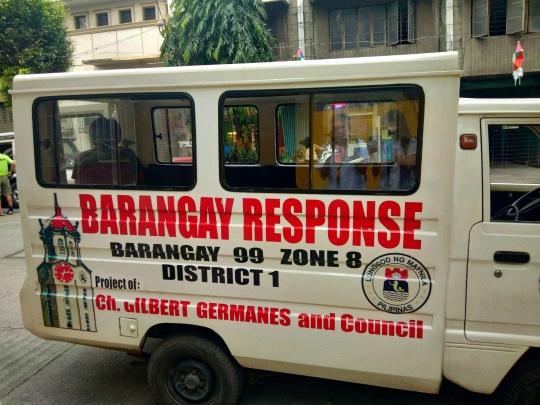
Because of the interview and community walk, I couldn’t help but also notice the issues that can be perceived to be small but can have a lasting effect. An issue I found confusing was how the barangay was missing a DRRM plan, which although crucial, seemed to be taken for granted since I was told there wasn’t really a need for it because the plans were all connected and “programmed” anyway in the council; that they were simply wired to be informed already. Another issue fell more under how the people don’t really follow the rules set out for them and their common good, even in the simplest things like proper waste disposal and taking segregation bins for granted. Pieces of trash can still be found scattered around the area despite having been provided with trash bins. These, in my opinion, are issues because it can affect everyone residing in the area and can be a cause for a domino effect that will gradually build up in the long run (ex. being a big factor for floods and health issues).
The mere fact that people continue to be careless despite being provided with a chance to come up with a solution (programs/plans) or have a solution (trash bins) right before their eyes tells something about the discipline that is lacking within the masses. This also influences people to go on with their misdeeds. This does not only apply to this particular community but to the whole country as a whole. It reflects the lack of effort of the citizens to do the simplest things to contribute to the betterment of other people and the environment. This is why change hasn’t come, and why a lot of bad things prevail in the country; because we can’t even follow something simple due to being undisciplined and careless. We need to be able to address this because people don’t even realize that due to these, more and more add up to being under the vulnerability list.
To increase the capacities of a community, it needs to start within the individual. The practice of thinking of the welfare of others should always be put in mind because as long as we care and live for the common good, there is hope. Perhaps, what the local government can do about it is conduct seminars and put up more infographics that are eye-catching will actually have an encouraging effect to the audience—activities that will leave a mark which will be remembered for a long time and can be taught by the elderly to the younger generation. Also, the local government can have somebody assigned to conduct a monthly check of the community area. Information can also be disseminated online to make use of the cyberspace where influence is strong and where almost everybody can be involved. But, all this cannot be possible if discipline isn’t present and maintained. There will not be grace amid disasters if people do not actually learn from what they did wrong which contributed to the worsening of a situation that eventually leads to a disaster.
2 notes
·
View notes
Text
Barangay 466, Sampaloc, Manila
This blog post will revolve on the topic of DRRM or Disaster Risk Reduction Management, which required me to interview a barangay leader that is part of the process in DRRM and after the interview, I will reflect on their way of planning, as well as its weaknesses and strengths.
I got the chance to interview a Barangay Councilman, also known as kagawad. He governs in Barangay 466, which is part of Sampaloc, Manila. Sir Francisco "Kiko" Vargas, is the kagawad who is in charge of the majority of streets around UST, familiarly to P. Noval and to Dapitan. He’s an approachable, kind man who knows what are the programs and procedures that are present in the barangay. One thing that stuck with me during the interview was that Sir Kiko’s main job was to help in times of calamity, for he is the head of the Justice Committee and DRRM head of the barangay.

The first thing that I asked him was about the calamities that usually happen around the barangay. Most of the calamities that affected the barangay were thunderstorms, and he emphasized that the Bagyong "Ondoy" was the strongest of them all.
Habagat and thunderstorms are common in the Philippines because our country is found beside the Pacific Ocean and as we all know, all of the storms come from the ocean. Another type of calamity that hit the barangay was the recent earthquake last April 2019, with a magnitude of 5.5 - 6.2 that mostly devastated in Region 3 but was still felt here in Manila. As for human-induced calamities, or disasters created by man, he stated that fire usually happens yet since the beginning of the school year, there were no reported fire incidents because the barangay focused on fire safety. Lastly, another calamity yet a very usual one was petty crimes like snatching and hold-up.
The second thing I asked what area is life-threatening, health hazardous and flood-prone. He stated that all streets are life-threatening, but no need to worry because there are people governed by the barangay taking rounds to make sure the area is safe from thefts and snatchers.. In terms of health and flood-related, P. Noval street was one of the places affected by the flood which went up to the chest area of an adult human. Until in 2009, the streets were elevated to prevent flooding but this diverted the flood the Espana and the campus of UST.

While in Dapitan, there are wires dangling that reached the floor of the streets that is certainly life-threatening especially during floods that can electrocute passersby that are unaware.

Last, is the construction happening inside the UST Campus, near the Roque Ruano building. The set-up could easily mess up during the earthquake since it looks fragile.

I asked him about the people that they prioritize during evacuation. Of course, people rather than personal items are their main priority when calamity strikes specifically, Senior Citizens, PWDs, women, and the Students of the University because the area is surrounded which students that are living in condominiums and dormitories. Calamity also affects the livelihood within the area such as eateries, coffee shops and more because employees can't go to work because of the flooding also not to mention, students can't go to their classes.
Let us now go to where the people will go when calamity comes. People are advised to go to higher ground or to the covered courts near the area. It is better to evacuate than to stay on their own houses/ buildings because their houses may be washed away by the floor or debris can fall on top of them.
Before disaster comes, the barangay officials conduct seminars, flash flood, and earthquake drills, general assembly for safety and security, extending duties of the rounds and lastly coordination with the school, police department and fire volunteers. so that people are aware and knowledgeable to do when the time has come. To also prevent flooding of the area they do monthly clean up of drainage and roads so that debris and trash won't go to the drainage. All of these programs are spearheaded by the Barangay Captain and the barangay kagawads.
So the issue that I can see that is confronting the community is that some of the civilians do not actively participate in the drills and also even though the barangay officials do their job to clean the streets still some of the people in the barangay still throw wherever they want. The government can address this problem by having visible law enforcement so that the people can learn that they can't throw their trashes anywhere and for the problem of inactive participation, we can tell them that this is for their own good and for their own safety. I think this scenario does not only apply to their barangay but rather the whole country, Filipinos should change for the better because some of their actions can only lead to more damage to themselves and even to others. As a student I can talk to the government to have additional supplies and also have a campaign where people are enjoined to clean, to know the importance of a clean environment.
What I learned in this is that "Prevention is better than cure". If we do our best to do better drainage and the people do not litter and stronger foundations for the house, then we can say that the world will be a better and safer place to live.
1 note
·
View note
Photo

Barangay 397 is one of the 241 barangays found in Sampaloc, Manila, with a total of 978 barangay population governed by Brgy. Capt. Resty L. Pineda. The barangay is located in front of the University of Santo Tomas, where the streets of Padre Noval and Galicia are located. On the other hand, the boundaries of the said barangay are the streets of Moret, Loyola, Tolentino, and España Boulevard. Since the area is near the University of Santo Tomas and Far Eastern University, you can find some low-cost rooms for rent and affordable eateries in the barangay. One of the most visited places in Barangay 397 is the famous Amo Yamie Crib in España. Here also stands the University Tower 1 and other than that, there is also a building under construction along the P. Noval Street.
1 note
·
View note
Text
DRRM Kwentuhan

This is a photo of me and Ms. Stella Songco, an official in Barangay 397, Zone 41, Sampaloc, Manila. I, together with some of my friends, conducted an interview and asked questions about DRRM practices they do under their authority. During our kwentuhan, she mentioned several problems that the barangay encounters during calamities and on normal days.

The scope of Barangay 397 starts from Tolentino St. passing through P. Noval Street until Galicia St. which are prone to flooding during heavy rainfall and thunderstorms. Earthquakes rarely happen in their vicinity, but if it does happen, Brgy. 397 is ready because they conduct earthquake drills to prepare the community and to minimize casualty if ever earthquakes may occur.


As to what was said in the interview, most of the calamities witnessed by the barangay in the past decade can be summarized within the range of a tropical storm, to a typhoon, and to a number of earthquakes. Ms. Stongco mentioned a few of the many hazards that Barangay 397 faces today. One includes the poor sewage system of Espana and the infrastructures built around the area without a strong foundation. She also mentioned how residents carelessly and irresponsibly neglect the proper disposal and management of their wastes. These acts greatly affect the clogging of the community’s sewage system.

Safe places in Barangay 397 are the condominiums. The barangay does not have its own evacuation center in case a calamity occurs due to financial reasons. It is advised to stay dry during these calamities, most especially in building with more than to floors to avoid diseases like dengue or leptospirosis if one is not careful with walking through flood water.

Best practices. Barangay residents are still aware of their surroundings. There is a sense of bayanihan as evident in the photo of a resident helping out someone park his car. There are also concerned residents who clean the streets and keep the roads peaceful. These acts done by residents contribute to the betterment of the community.
Reflection
Our kwentuhan with Ms. Stongco turned out to be a great learning experience for me and my friends. I learned a lot on the different protocols and measures that they practice in order to keep the barangay safe and prepared at times of disaster and calamities. Barangay 395 is mostly populated with business establishments and student dormitories thus it is more vulnerable to a high number of casualties when disaster strikes. Ms. Stongco is confident throughout the interview that they are doing their best to ensure the safety of the community. Their primary concern is the threshold of the community.
There is so much room for improvement in this community, and I believe that by working hand in hand, we can maximize this community has to offer. Shaping the future begins in us and in our generation, which is why we must all make our community a better place to live in. This module made me realize that time is running fast, and if the future is in our hands. I must take care of my environment, and it all starts in the community that I live in.
1 note
·
View note
Text
Manila City is one of the densest city in the Philippines as of today. It is notable for such its unruly physical and economic growth. Rural migrants had pour in the metro desperate for search of work and life. These people settle in margin of the land but when nothing, they build make shift home on stilts above Manila Bay and Pasig River. Discussing about NEIGHBORHOOD AND BUILT ENVIRONMENT. Esteros, railways, garbage dumps, bays, rivers and its tributaries and other public areas such as sidewalks, highway, and parks. The Capital is currently facing various adversities that include mainly, provision for public health service, housing, water system, sewage service, garbage management, transportation, and education. Everything is insufficient due to high increase of migrants and the people of the city itself. I cannot blame the city for this but I think if this is the case, the government needs to prioritize the city to cater all the needs in improving the knowledge and health of individuals, family and communities. As dramatic increase in population over the past two decades that put effect on the urban community, I cannot emphasize how its ECONOMIC STABILITY is going. I have encountered a post that Manila City ranks top 3 among the richest cities here in the philippines. I pressume that despite of the population increase, Manila remained multi-faceted. It remained as the center of commercial, cultural, political and social industry and manufacturer of diverse products. In my own percepts, the reason why it did not hog top to Rank 1 because in Makati it centers to investments to like malls, estates and such but in Manila it’s like all life status dwells in here and ‘some’ benefits go to the people with nothing in return. There is no doubt that Manila is also the center for EDUCATION, and I myself is the evidence. I came all the way from Laguna just to study here because I do believe that the quality of education is high. Since the spanish era, top universities like UST, ADMU, DLSLM, UP, PUP and other universities along the U-belt have been established. Not just for education that it excels but in sports as well that improve not just the concentration of higher education but extra curricular activities. These schools offer courses that are not available in other places as to why people really go here in manila for college. I also observed that there are lots of public schools and science schools which is good most especially for our young children who is not privileged enough to study. Public HEALTH and HEALTHCARE is provided by private corporations since majority of the hospitals in manila are privately owned. Just like in Education, people from south and north go to manila for the quality of healthcare. San Lazaro Hospital is a hospital that I always hear about ever since I was a child who manages cases for communicable diseases. The headquarters for WHO Country Office and DOH is designated at NCR. Around 6 hospitals are also accredited by Joint Commission International and based on my my research, with its multitude health workers and health providers, NCR has the lowest rate of malnutrition but I don’t really believe because it is occupied by nearly slums and squatter areas wich I think unprivileged individuals reside. Talking about SOCIAL AND COMMUNITY CONTEXT. I think the metropolitan area sufficiently and unsufficiently caters this depending on various circumstances and districts. Manila has 16 cities and designated as the Global Power City, it has a very significant role to finance, media, art, commerce, fashion, research, technology, education and entertainment concluding that all lifestyles are here. Housing in Manila varies from high-end to low-end. Condominiums and High-rise buildings have risk due to their elevation and having less number of windows. Starting a family as well in this type of housing would not contribute greatly to social developmental characteristics of a child. Another type of housing are those of along esteros that is detrimental to an individual’s health. No proper ventilation, weak structure, exposed to areas such as contaminated rivers and dumpsites. I also wanna take on consider the improper waste disposal of these people living in manila especially along P. Noval St. here in Sampaloc. Garbage are not tightly disposed, leaving leaks and unwanted odor. When it comes to public safety, the city also houses the Philippine National Police. I strongly believe that if there is a mutual give and take relationship with the people and government we could create a better place to live in. It will all start from the self, the practice of honesty, generosity and discipline.
3 notes
·
View notes
Photo

#filmphotography #filmisnotdead #pentaxk1000 #shootfilm (at P. Noval Street, Sampaloc, Manila) https://www.instagram.com/p/CGyLIh4Fjpl/?igshid=13dnharbe3ic2
0 notes
Text
Iron Pan, P. Noval Street, Sampaloc, Manila


One of my comfort food is Steak, If steak is not expensive, I’d eat it all-day-everyday. We recently found a steak gem near UST, It’s affordable and it’s student-priced dishes.
They are located in one of the buildings I. Delos Reyes Corner P. Noval Street, Sampaloc, Manila. It’s kinda hard to find it because it’s on the second floor and most of the people we ask are not familiar with the restaurant. The place is not that big and it can only accommodate 7-10pax. Luckily when we planned to go there, it’s a holiday we didn’t experience how jampacked it is during school days.
Let’s try their dishes!

Prime Rib Eye (P199)

T-bone (P135)

Chicken Cordon Bleu (P89)

Lechon Kawali (P89)
Overall, their steak is good but the 30% portion of the steaks are bones. it is thinly sliced there is nothing wrong with it because it’s affordable. Their Pepper gravy made all their dishes more flavorful, it’s so good that it made me finish a cup of rice. If you want to skip Beef and Pork, then go to Chicken Cordon Blue, It is very flavorful with or without the garlic sauce.
I suggest to try Iron Pan if you’re in the are, not just affordable but the food is good.
0 notes
Photo

🎄12 DAYS OF CHRISTMAS🎄 #TheCubeStore12daysofChristmas #TheCubeStorePHxSirenTreasureBox ROUND 2! 🙌 10th day of Christmas! 2 lucky winners will get a chance to take home Php750 worth of Siren TreasureBox @sirentreasurebox products! 😱 Winners will be announced on Saturday 8PM 😀 To join: - Follow us on our official Instagram @thecubestore.ph and @sirentreasurebox - Like this post - Repost this post on your Instagram Story - Tag our official Instagram Accounts - Use our official hashtags #TheCubeStorePH #SirenTreasureBox #TheCubeStorePHxSirenTreasureBox #TheCubeStore12daysofChristmas - Tag 2 friends via this post's comment section Easy, right? 😉 Visit our branches: ⬇️ -The Cube Store P. Noval Branch, 2nd floor 1053 Padre Noval Street, Sampaloc Manila -The Cube Store Taft Branch, Ground Floor Unit 8B One Archer's Place Taft Avenue, Malate Manila https://www.instagram.com/p/B6Q35OoBhEB/?igshid=j2xmwclalu24
0 notes
Text

(photo extracted from https://br.freepik.com/fotos-vetores-gratis/furacao)
Last step: Capacity and Disaster Management Assessment
The barangay officials work with different NGOs to prevent severe impacts of calamities to the community. In Barangay 466, the main sector involved in the Raha Volunteers Fire Department. They are in-charge of providing assistance to fire incidents throughout the metro. The barangay also has its own BDRRM planwhich consists of 11 steps:
1. Encouraging our constituents always monitor and follow the instructions thru the social and mass media for any official announcements of weather conditions and suspensions of classes from the Local Government (City of Manila) and other government agencies like PAG-ASA.
2. Be ALERT to the possibility of flood, if it has been raining for several days. Flood happens as the ground becomes saturated.
3. If advised to evacuate, DO SO!
4. Don’t panic, move to a safe area before access is cut off by flood waters.
5. Store drinking water in containers, AND OTHER related items like survival kits water service may be interrupted.
6. Move household belongings to upper levels. Get livestock to higher ground.
7. Turn off electricity at the main switch in the building before evacuating and also lock your house.
8. Avoid areas subject to sudden flooding.
9. Do not attempt to cross rivers of flowing streams where water is above the knee.
10. Beware of water-covered roads and bridges.
11. Awareness campaign with Barangay Officials and the Community…
The awareness campaign was implemented during the time of Mayor Erap as it was name Emergency Response Assistance Program. This included posters regarding the dos and don’ts during earthquakes, typhoons, and fire incidents. Along with this, the barangay conducted declogging of 6 major streets in Sampaloc: P. Noval, Dapitan, Alfonso Mendoza, etc. This is to prevent flooding in the area and to control pest infestation.
0 notes
Text
KNOW: Barangay 469
Barangay 469 is located in Sampaloc, Manila near the vicinity of The University of Santo Tomas. It has a population of approximately 590 people. The barangay encompasses 2 blocks where its boundaries are P. Noval Street, G. Tolentino Street, Delos Reyes Street, and Espanya Boulevard. It is a community full of dormitories for the students studying in the nearby University of Santo Tomas. The community has a nearby church in UST where people could attend Sunday masses. It also has a nearby hospital also found in UST. The barangay office is accessible and near from the people living in that area. There are also posters in the community that gives awareness regarding what to do during disasters.

These are some photos taken during interview. The person I interviewed was Kuya Ricky “Ric” Albarios, the barangay secretary.

This is the office of Barangay 469 as well the map that shows the area it encompasses.
0 notes
Text
STEP ONE: COORDINATE WITH YOUR BARANGAY OFFICIAL

Barangay 397 zone 41
840 P. Noval St. Sampaloc, Manila
0 notes
Photo

What’s this? I found a raggedy doll, who slept on me while I waited on the streets. Lovely chat, luv. 😘💕 (at P. Noval Street, Sampaloc, Manila) https://www.instagram.com/p/B4u0lL1Fyfq/?igshid=uiub3yc2xc70
0 notes
Video
Kung kelan nasa españa ako, tsaka umuulan nang malakas at nag-uumpisa pang bumaha ata sa labas Magaling, angelie. Lalangoy ka ngayon hahaha xD (at P. Noval Street, Sampaloc, Manila) https://www.instagram.com/p/B3eoy_Mh0pw/?igshid=1l64h19xv6zpo
0 notes
Text
Tweeted
Samgyuppppp😍 @ P. Noval Street, Sampaloc, Manila https://t.co/rX8M9EJyGf
— Tobio (@CyronMagbuo11) March 17, 2019
0 notes
